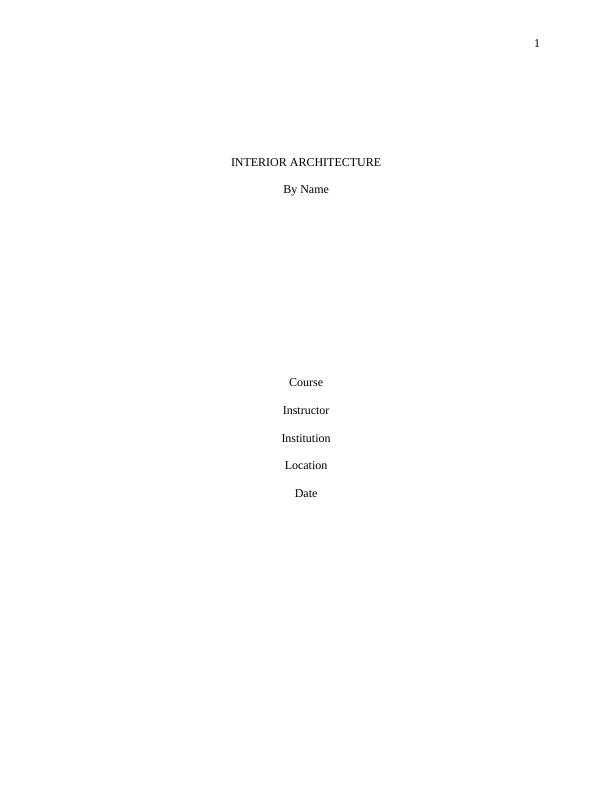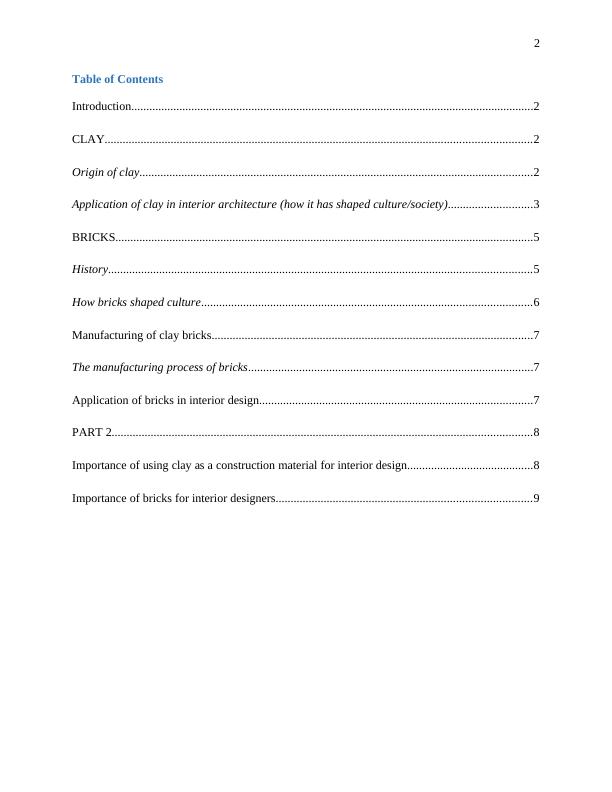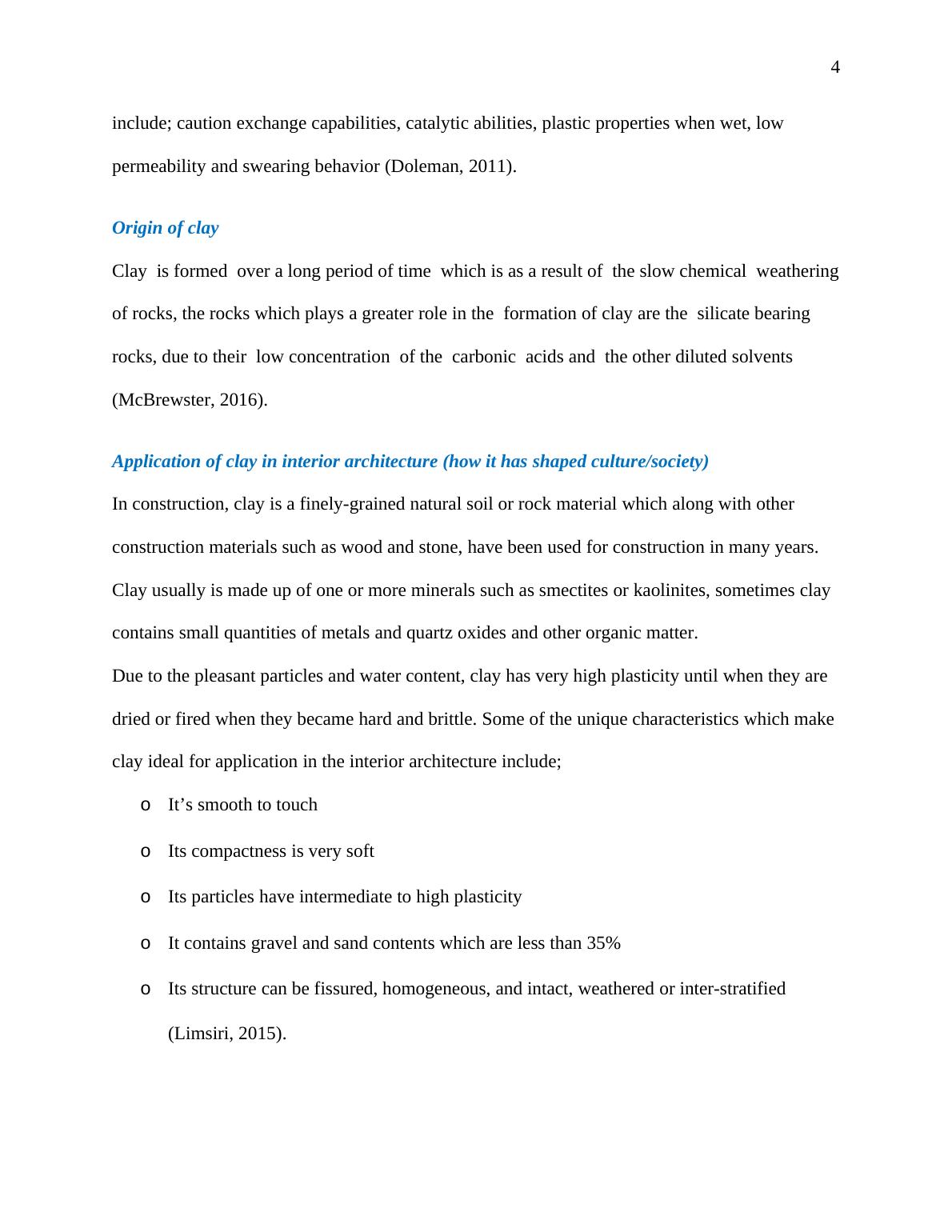Clay and Bricks in Interior Architecture
Added on 2022-12-20
12 Pages2311 Words87 Views
1
INTERIOR ARCHITECTURE
By Name
Course
Instructor
Institution
Location
Date
INTERIOR ARCHITECTURE
By Name
Course
Instructor
Institution
Location
Date

2
Table of Contents
Introduction......................................................................................................................................2
CLAY..............................................................................................................................................2
Origin of clay...................................................................................................................................2
Application of clay in interior architecture (how it has shaped culture/society)............................3
BRICKS...........................................................................................................................................5
History.............................................................................................................................................5
How bricks shaped culture..............................................................................................................6
Manufacturing of clay bricks...........................................................................................................7
The manufacturing process of bricks...............................................................................................7
Application of bricks in interior design...........................................................................................7
PART 2............................................................................................................................................8
Importance of using clay as a construction material for interior design..........................................8
Importance of bricks for interior designers.....................................................................................9
Table of Contents
Introduction......................................................................................................................................2
CLAY..............................................................................................................................................2
Origin of clay...................................................................................................................................2
Application of clay in interior architecture (how it has shaped culture/society)............................3
BRICKS...........................................................................................................................................5
History.............................................................................................................................................5
How bricks shaped culture..............................................................................................................6
Manufacturing of clay bricks...........................................................................................................7
The manufacturing process of bricks...............................................................................................7
Application of bricks in interior design...........................................................................................7
PART 2............................................................................................................................................8
Importance of using clay as a construction material for interior design..........................................8
Importance of bricks for interior designers.....................................................................................9

3
Introduction
Since ancient times there has been material processing, which involves a series of operations
which transforms material from their natural/raw state to finished products (Reeves, 2017). The
processing of materials by hand is as old a civilization, the mechanical or industrial processing of
material started with the industrial revolution of the 18th century, and early 19th century, whereby
basic machines were invented. The material processing, of converting the raw materials into
finished products starts immediately when the raw materials are extracted from their natural
settings. For this given paper, the focus is on how clay as being used in the interior design and
the finished products (Bricks ) Have also be used and make a conclusion on their benefits to the
interior designers (Sims, 2012). Clay is a finely-grained natural soil or rock material which along
with other construction materials such as wood and stone, have been used for construction in
many years. Clay usually is made up of one or more minerals such as smectites or kaolinites,
sometimes clay contains small quantities of metals and quartz oxides and other organic matter
while bricks are rectangular shaped blocks which are generally made from sun-dried or fired clay
which and are used for construction purposes.
Clay
Clay refers to the naturally occurring material which is made up of fine-grained minerals, clay is
usually plastic at the contents and it will usually harden when dried or fired. Clay is usually
composed of silicate minerals which are less than 2 microns in size. Clay materials are plentiful
at the earth’s surface, they are main components in nearly all the sedimentary rocks and they
form rocks referred to as shales. The unique crystal structure and the small size of the particles
give clay special properties to be used in construction. Some of the unique properties of clay
Introduction
Since ancient times there has been material processing, which involves a series of operations
which transforms material from their natural/raw state to finished products (Reeves, 2017). The
processing of materials by hand is as old a civilization, the mechanical or industrial processing of
material started with the industrial revolution of the 18th century, and early 19th century, whereby
basic machines were invented. The material processing, of converting the raw materials into
finished products starts immediately when the raw materials are extracted from their natural
settings. For this given paper, the focus is on how clay as being used in the interior design and
the finished products (Bricks ) Have also be used and make a conclusion on their benefits to the
interior designers (Sims, 2012). Clay is a finely-grained natural soil or rock material which along
with other construction materials such as wood and stone, have been used for construction in
many years. Clay usually is made up of one or more minerals such as smectites or kaolinites,
sometimes clay contains small quantities of metals and quartz oxides and other organic matter
while bricks are rectangular shaped blocks which are generally made from sun-dried or fired clay
which and are used for construction purposes.
Clay
Clay refers to the naturally occurring material which is made up of fine-grained minerals, clay is
usually plastic at the contents and it will usually harden when dried or fired. Clay is usually
composed of silicate minerals which are less than 2 microns in size. Clay materials are plentiful
at the earth’s surface, they are main components in nearly all the sedimentary rocks and they
form rocks referred to as shales. The unique crystal structure and the small size of the particles
give clay special properties to be used in construction. Some of the unique properties of clay

4
include; caution exchange capabilities, catalytic abilities, plastic properties when wet, low
permeability and swearing behavior (Doleman, 2011).
Origin of clay
Clay is formed over a long period of time which is as a result of the slow chemical weathering
of rocks, the rocks which plays a greater role in the formation of clay are the silicate bearing
rocks, due to their low concentration of the carbonic acids and the other diluted solvents
(McBrewster, 2016).
Application of clay in interior architecture (how it has shaped culture/society)
In construction, clay is a finely-grained natural soil or rock material which along with other
construction materials such as wood and stone, have been used for construction in many years.
Clay usually is made up of one or more minerals such as smectites or kaolinites, sometimes clay
contains small quantities of metals and quartz oxides and other organic matter.
Due to the pleasant particles and water content, clay has very high plasticity until when they are
dried or fired when they became hard and brittle. Some of the unique characteristics which make
clay ideal for application in the interior architecture include;
o It’s smooth to touch
o Its compactness is very soft
o Its particles have intermediate to high plasticity
o It contains gravel and sand contents which are less than 35%
o Its structure can be fissured, homogeneous, and intact, weathered or inter-stratified
(Limsiri, 2015).
include; caution exchange capabilities, catalytic abilities, plastic properties when wet, low
permeability and swearing behavior (Doleman, 2011).
Origin of clay
Clay is formed over a long period of time which is as a result of the slow chemical weathering
of rocks, the rocks which plays a greater role in the formation of clay are the silicate bearing
rocks, due to their low concentration of the carbonic acids and the other diluted solvents
(McBrewster, 2016).
Application of clay in interior architecture (how it has shaped culture/society)
In construction, clay is a finely-grained natural soil or rock material which along with other
construction materials such as wood and stone, have been used for construction in many years.
Clay usually is made up of one or more minerals such as smectites or kaolinites, sometimes clay
contains small quantities of metals and quartz oxides and other organic matter.
Due to the pleasant particles and water content, clay has very high plasticity until when they are
dried or fired when they became hard and brittle. Some of the unique characteristics which make
clay ideal for application in the interior architecture include;
o It’s smooth to touch
o Its compactness is very soft
o Its particles have intermediate to high plasticity
o It contains gravel and sand contents which are less than 35%
o Its structure can be fissured, homogeneous, and intact, weathered or inter-stratified
(Limsiri, 2015).

End of preview
Want to access all the pages? Upload your documents or become a member.
Related Documents
Clay-Based Masonry Mortars as a Construction Materiallg...
|21
|5466
|389
Selection of Building Materials: Raw Materials, Manufacturing Process, Onsite Installation, Testing Techniques, Advantages and Disadvantageslg...
|13
|2197
|249
(PDF) The Role of the Built Environment in Human Lifelg...
|14
|3169
|274
Clay perviousness is said to be dependent on list of factors including addition of sandy. November 3, 2016lg...
|7
|1699
|482
Fly Ash Cement pva fibers Assignment PDFlg...
|9
|3059
|23
Identifying Building Styles and Reporting Property Defectslg...
|12
|2509
|76
